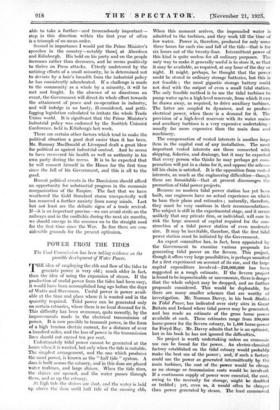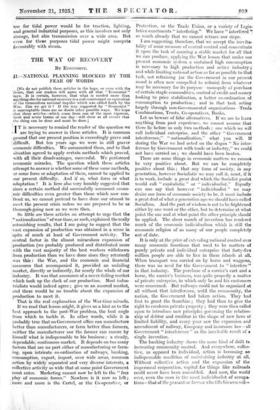POWER FROM THE TIDES
The Coal Commission has been taking evidence on the possible development of Water Power. THE idea of employing the ebb and flow of the tides to generate power is very old ; much older in fact, than the idea of using the expansion of steam. If the production of useful power from the tides had been easy, it would have been accomplished long ago before the days of Watts and Stevenson. Useful power is power avail- able at the time and place where it is wanted and in the quantity required. Tidal power can be generated only on certain estuaries, where there is no local demand for it. This difficulty has been overcome, quite recently, by .the improvements made in the electrical transmission of power. It is now possible to transmit power, in the form of a high tension electric current, for a distance of over a hundred miles, and the loss of power in the transmission lines should not exceed ten per cent.
- Unfortunately tidal power cannot be generated at the hours When it is wanted, but only when the tide is suitable. The simplest arrangement, and the one which produces the most *pc). i-er, is known as the " halt tide " system._ A dam is built across the estuary, and in this dam are placed water turbines, and large sluices. When the tide rises, the sluices are opened, and the water passes through them, and so up the estuary. - .
At, high tidethe sluices are shut, and the water is held up above the 'dam until half tide of the ensuing ebb. When this moment arrives, the impounded water is admitted to the turbines, and they work till the time of low water. Power is, therefore, produced for only some three hours for each rise and fall of the tide—that is for. six hours out of the twenty-four. Intermittent power of this kind is quite useless for all ordinary purposes. The only way to make.it generally useful is to store it, so that it may be available, as required, at any hour of the day or night. It might, perhaps, be thought that the power could be stored in. ordinary storage batteries, but this is not feasible ; the most gigantic- storage battery could not deal with the output of even a small tidal station. : The only feasible method is to use the tidal turbines to: pump water up to a high level reservoir, from which it can be drawn away, 'as required, to drive auxiliary turbines. The latter are coupled to dynarhos, and so produce electrical power, when -there -is a demand for it. The provision of a high-level reservoir with its water mains and auxiliary turbines is a very expensive undertaking ; usually far more expensive than the main dam and machinery.
.The compensation of vested interests is another large item in the capital cost of any installation. The most important vested interests, are those connected with shipping, fisheries, and drainage, but it may be expected that every person who thinks he may perhaps get com- pensation will put in a claim for it, and oppose the scheme till his claim is satisfied. It is the opposition from vested interests, as much as the engineering difficulties—though these are formidable—that at present discourages the promotion of tidal power projects. _ Because no modern tidal power station has yet been built,- our engineers have no actual experience on which to base their plans and estimates ; naturally, therefore, they must be very cautious in their recommendations. The subject is still in the experimental stage, and it seems unlikely that any private firm, or individual, will care to risk the large amount of capital required for. the con- struction of a tidal power station of even moderate size. It may be inevitable, therefore, that the first tidal power station must be initiated by the Government. .
An expert committee has, in fact, been appointed by the Government to examine various proposals for generating tidal power on . the Severn. This project, though it offers very large possibilities, is perhaps unsuited for a first experiment on account of its size, and the large capital expenditure involved—£28,000,000 has been suggested as a rough estimate. If the Severn project is found to be impracticable or uneconomic, there is danger that the whole subject may be dropped, and no further proposals considered. This would be deplorable, for there are many smaller schemes that are worthy of investigation. Mr. Norman Davey, in his book Studies in Tidal Power, has indicated over sixty sites in .Great Britain and Ireland where tidal power may be generated, and _ has . made an estimate of the gross horse power available at each. These estimates range from 390,000 horse-power for the Severn estuary, to 1,400 horse-power for Foryd Bay. Mr. Davey admits that he is an optimist, but in his book he has not ignored the difficulties.
_ No project is worth' undertaking unless an economic use can be found for the power. An electrochemical: factory established on the tidal estuary would probably' Make the best use of the power ; 'and,- if such a factory could use the power as generated, intermittently by thd main turbines, the .cost of the power would be cheap as no storage or transmission costs would be involved: If a continuous supply of power were essential, the cost; owing to the necessity for storage, might he doubled- or trebled ; yet, even so, it would often be cheaper than power generated by steam. The least economical use for tidal power would be for traction, lighting, and general industrial purposes, as this involves not only storage, but. alio transmission over a wide area. But for these purposes tidal power might compete favourably with steam. -















































 Previous page
Previous page